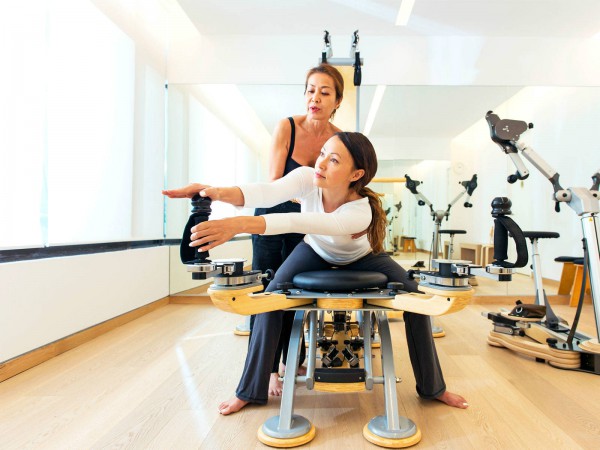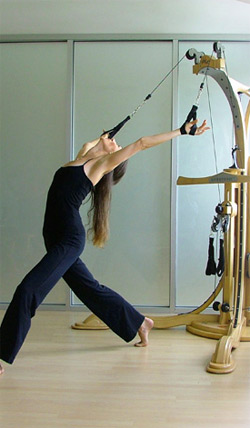Gyrotonic is a unique system of exercise that incorporates movement principles from yoga, dance, gymnastics, swimming and t’ai chi. Central to gyrotonic is the Gyrotonic Expansion System, or GXS, a specially designed wooden machine with rotational discs and weighted pulleys that allow the exerciser to strengthen their muscles using flowing, circular movements.

The Gyrotonic Expansion System is composed of the Gyrokinesis and Gyrotonic exercise methods. The Gyrokinesis Method, originally called “Yoga for Dancers,” is practiced on a mat & chair, and the Gyrotonic Method uses specialized equipment that permits one to move with support and resistance. Gyrotonic and Gyrokinesis exercise sequences are intended to increase the functional capacity of the entire organism in a harmonious way. Both methods embrace key principles also found in swimming, dance, yoga, tai chi, and gymnastics, and emphasize continuous, flowing movements, synchronized with corresponding breath patterns. Gyrotonic and Gyrokinesis exercise sequences are usually taught in a one hour private or group class at a Gyrotonic studio, or fitness facility.
Principles of Gyrotonic Expansion System
Four primary principles of the Gyrotonic Expansion System are listed below.
Intention
“Intention is the driving force that moves the body.”(Juliu Horvath) It is a person’s vision that guides his/her movement in the desired direction.
Stabilization through Contrast
“Instead of attempting to create stabilization by fixing or holding the body in a particular position, The Gyrotonic Expansion System encourages the mover to find a balance between reaching, or lengthening outward (extending or expanding), and pulling inward toward the bodies core (tensing, or retracting). This opposition is not static, instead there is a continuous wave like pulsation of reaching out, and reeling in from the center of the body. In this way stability is attained by a counterbalance of opposing forces.” (Joyce Campbell)
Decompression of the joints
Joints that are overly compressed cannot move freely. Decompression of the joints can be attained by utilizing the principle of stabilization through contrast, along with cuing exercisers to articulate joints with a scooping, curvilinear motion. By creating a scooping motion, and moving around joints in a circular manner, greater space may be attained in the joints, optimizing the quality,and efficiency of most joint movements.
Coordination of movement and breath
The Gyrotonic Expansion System stresses the value of using a corresponding breath pattern for each movement. Generally this involves inhaling when a movement is intended to expand, or open, and exhaling when a movement is intended to contract, or close.
Benefits
Some of the benefits that may be gained by practicing the Gyrotonic,and Gyrokinesis methods are increased circulation; cardiovascular stimulation; increased mobility of the joints; stimulation, and strengthening of the nervous system; mobilization of the spine; improved sense perception; greater balance, and flow of energy; and improved coordination.
Gyrotonic equipment
The Gyrotonic Method utilizes specially designed exercise equipment. All Gyrotonic equipment is developed by Gyrotonic Expansion System Creator, Juliu Horvath. Horvath designed Gyrotonic equipment to accommodate the natural movement patterns of the human body. Gyrotonic equipment incorporates curvilinear wooden framework, and has numerous adjustments so that it can be customized to each users unique physique, and physical ability.
There are five different models of Gyrotonic equipment used commercially by Gyrotonic trainers. The Pulley Tower Combination Unit is the most widely used piece of Gyrotonic Equipment. The other four models of equipment are categorized as Specialized Equipment. Gyrotonic Specialized Equipment includes: the Jumping Stretching Board, the Gyrotoner, the Leg Extension Unit, the Archway.
Beatriz Pascual is attributed as the woman who introduced gyrotonic to the UK. Trained by Julio Horvath, who created the system, she has her own studio in London, and also runs gyrotonic teacher training programmes (gyrotonic.co.uk). ‘Gyrotonic may resemble Pilates,’ says Pascual, ‘but it is much more like yoga in its origin and breathing techniques.
 Pilates followers often make the mistake of thinking it’s the same and then find it difficult to master the breathing, which is specific to each particular movement pattern.
Pilates followers often make the mistake of thinking it’s the same and then find it difficult to master the breathing, which is specific to each particular movement pattern.
‘The machine facilitates your movements,’ Pascual continues, ‘but it makes you do the work, not the other way round. You will feel better after one session, but overnight miracles aren’t going to happen – this is one of the biggest issues I have explaining to my clients. It takes at least five to 10 sessions to understand the principles behind gyrotonic.
‘Gyrotonic is three-dimensional in its range of movements, and this is unique to this form of exercise. Individuals who are used to working in linear movements are often surprised by how little control they have of their bodies in this way – so you need to be consistent with your sessions to see the benefits. Once a week is good, but twice a week is preferable.
‘Connecting with your body and getting the breathing right is crucial to getting the most out of gyrotonic – which means switching off and leaving the pressures of life outside.
Establishing this state of active relaxation can be hard, especially when you are concentrating on mastering new body skills and trying to do your best. Gyrotonic is a complete system of exercising: it articulates your joints, improves the flow of energy through the body, stimulates acupuncture points, builds stamina and strength and improves health.’
To find a teacher, your best bet is to log on to gyrotonic.com, the central website for everything there is to know about gyrotonic. Simply type in your postcode and the website will come up with a list of teachers and studios near you.
An introductory gyrotonic session will always focus on a warm-up before moving on to working on the GXS machine. Exercises start with movements at the base of the spine and progress to the arms, neck and shoulders. Pulleys with straps are attached to your feet as your legs are stretched and strengthened, while at the same time encouraging movement in the abdominal muscles. Each class is one-on-one and lasts for about an hour. Since the machines are quite big and the system very specific, small group classes aren’t that common, and the average class costs around £45.
Gyrotonic may have originated as a way of helping dancers, but its teachers consider it to be beneficial for just about anyone, including youngsters, those with arthritis and individuals seeking rehabilitation.
When finding out more, you may also come across gyrokinesis, which is a kind of floor version of gyrotonic. Since it does not use the big equipment, gyrokinesis classes tend to be run as small groups and are cheaper – expect to pay around £12 a session.
When it comes to kit, all you need is a T-shirt, a pair of comfortable leggings and some socks. You could do gyrotonic barefoot, but socks are preferred for reasons of hygiene. But if you’re one of those people who prefers to cut more of a dash when they’re exercising and who enjoys wearing specific functional clothing, then Adidas, Nike and Puma, among the major sports brands, offer the best selection. Labels such as Cassal, Fuerteventura, Bell Ferguson, Sweaty Betty (sweatybetty.com) and She Active (sheactive.com) also offer some stylish yet functional choices.
Although there are some potential cardiovascular benefits from gyrotonic, you’re not going to end each session in a pool of sweat, so while breathable clothing is preferable, forking out for technically designed kit is not essential. If you do get hooked and want your own GXS equipment to use at home, it will set you back at least £2,500.
All the training, equipment, teacher training certification and DVD products – just about anything to do with gyrotonic, in fact – goes through Julio Horvath’s website, gyrotonic.com.
I also have quite a sweet tooth and love to have chocolate in one form or another for my lunch dessert.
Videos
Disclaimer
The Content is not intended to be a substitute for professional medical advice, diagnosis, or treatment. Always seek the advice of your physician or other qualified health provider with any questions you may have regarding a medical condition.